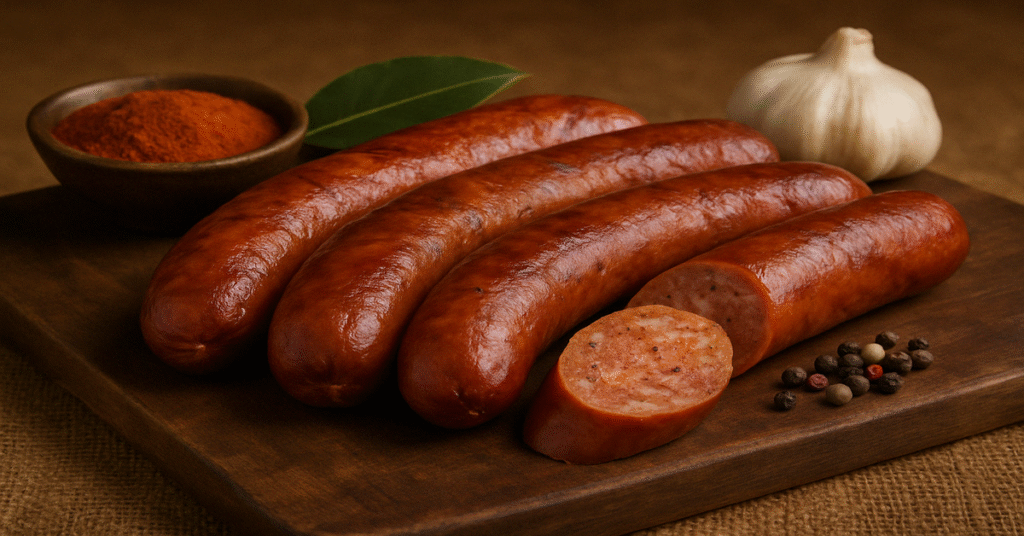What is Andouille Sausage?
Andouille sausage is a flavorful, smoked pork sausage known for its bold seasoning, coarse texture, and cultural significance in various cuisines—most notably French and Cajun/Creole cooking. It is celebrated for its smoky aroma, spicy notes, and versatile use in a variety of savory dishes.
Origins and Cultural Background
French Roots
The original form of andouille sausage comes from France, where it was traditionally made using pork chitterlings, stomach, and intestines, heavily seasoned and stuffed into large casings. It was a regional specialty often associated with Normandy, Brittany, and Alsace. The sausage was smoked and aged to intensify flavor.
Arrival in Louisiana
French immigrants brought andouille to Louisiana, where it evolved under the influence of Creole and Cajun culinary traditions. Unlike its French predecessor, the Louisiana version used pork shoulder or butt, garlic, onions, cayenne pepper, and other spices. It became a staple in dishes such as gumbo, jambalaya, and red beans and rice.
Cultural Significance
In Louisiana, andouille is more than food—it’s part of a broader cultural identity. It represents the fusion of European and Southern flavors and reflects the resourcefulness and flavor preferences of the region’s communities.
Ingredients and Preparation
Traditional Ingredients
Classic andouille sausage typically includes:
- Pork shoulder or butt
- Garlic
- Onions
- Black pepper
- Cayenne pepper
- Paprika
- Salt
- Herbs like thyme or bay leaf
In some traditional Cajun recipes, wine or vinegar is also used as a flavor enhancer.
Grinding and Stuffing
The pork is usually coarsely ground, which gives andouille its distinctive chunky texture. The meat is mixed with spices, cured briefly, and stuffed into natural casings, often pork intestines.
Smoking Process
After stuffing, the sausage is double smoked, which sets andouille apart from many other sausages. The first smoking often lasts for several hours using hickory or pecan wood, imparting a deep smoky flavor. The second smoking is lighter and typically happens after partial aging or resting.
Flavor Profile and Texture
Bold and Spicy
Andouille is known for its bold, peppery, and smoky flavor. The spices, particularly cayenne and black pepper, bring heat without overwhelming the palate. Garlic and onion provide depth, while the smoking process enhances complexity.
Coarse and Firm
Unlike finer sausages like bratwurst or frankfurters, andouille has a coarse, chunky texture. Each bite delivers a mixture of meat and spice, creating a rustic mouthfeel that pairs well with hearty dishes.
Regional Variations
French Andouille
In France, andouille is often made from tripe and organ meats, resulting in a strong, gamey flavor and a dense texture. It is traditionally boiled or grilled and served in slices, sometimes cold. This version is milder in spice but more intense in aroma.
Cajun Andouille
The Cajun andouille from Louisiana uses lean cuts of pork, incorporates chili-based spices, and is heavily smoked. It is typically used as a cooking ingredient, rather than eaten on its own.
Commercial Adaptations
Mass-market versions of andouille are often milder, using smoked pork and commercial spice blends. These products are more accessible but may lack the authenticity of artisan or locally made andouille.
Cooking Applications
Gumbo
One of the most iconic dishes using andouille is gumbo, a thick stew made with a dark roux base, vegetables, seafood or meat, and served over rice. Andouille adds smokiness and depth, often paired with chicken or shrimp.
Jambalaya
In jambalaya, andouille is sautéed with onions, peppers, and tomatoes, then cooked with rice and broth. The sausage infuses the rice with flavor and holds its structure well during cooking.
Red Beans and Rice
Red beans and rice is another classic Creole dish where andouille sausage is simmered with red beans, spices, and aromatics. It provides the smoky richness that defines the dish.
Grilled or Sautéed
Andouille can be grilled, pan-fried, or broiled on its own. It pairs well with mustard sauces, pickles, and crusty bread. In charcuterie settings, it’s sometimes sliced and served cold or at room temperature.
Soups and Pastas
Chopped andouille enhances soups, chowders, and pasta dishes. Its ability to release flavorful oils when cooked makes it a powerful ingredient in creamy sauces and bean-based broths.
Nutritional Considerations
Caloric Content
Andouille sausage is calorie-dense, with most of its energy coming from protein and fat. A single 2-ounce link typically contains around 150–200 calories, depending on the brand and fat content.
Sodium and Spice
It tends to be high in sodium, due to the curing process and seasoning blend. People on low-sodium diets should consume it in moderation.
Additives in Commercial Varieties
Commercially produced andouille may contain preservatives, nitrates, and MSG. Artisan and local producers often offer clean-label versions free from synthetic additives.
Pairings and Serving Suggestions
Side Dishes
Common sides include:
- Collard greens
- Cornbread
- Coleslaw
- Potato salad
- Pickled okra
These provide cooling or tangy contrasts to the sausage’s rich, smoky flavor.
Beverage Pairings
Andouille pairs well with:
- Dark beer (porter, stout)
- IPA
- Dry red wines (Zinfandel, Syrah)
- Bourbon or spicy rye whiskey
These beverages complement the sausage’s bold seasoning and smoky notes.
Storage and Shelf Life
Fresh Andouille
Fresh andouille should be stored refrigerated and used within 5–7 days. It can be frozen for up to 3 months without major loss of flavor.
Cooked or Smoked Varieties
Fully cooked or double-smoked andouille can last 2–3 weeks in the fridge if sealed. Always check for expiration dates and signs of spoilage like sour odor or slimy casing.
Canning and Vacuum Sealing
Some producers offer canned or vacuum-sealed andouille. These products can last up to a year unrefrigerated and are popular in camping or emergency food supplies.
Making Andouille at Home
Equipment Needed
To make andouille sausage at home, you’ll need:
- Meat grinder
- Sausage stuffer
- Smoker or grill with indirect heat
- Digital thermometer
- Natural casings
- Kitchen scale and mixing bowls
Basic Recipe Overview
- Grind 5 lbs of pork shoulder.
- Mix with spices (garlic, onion, paprika, salt, cayenne, thyme).
- Stuff into natural casings.
- Air-dry for a few hours.
- Smoke at 180–200°F until internal temp reaches 160°F.
- Cool and store appropriately.
Tips for Success
- Keep meat and equipment cold to avoid smearing fat.
- Don’t overstuff the casing—allow for expansion.
- Use a digital scale for precise seasoning.
Andouille vs. Other Sausages
Andouille vs. Chorizo
While both are spicy, chorizo uses paprika and vinegar, and often includes pork fat and offal. Andouille is more smoky, coarsely ground, and less greasy.
Andouille vs. Kielbasa
Kielbasa is a Polish sausage, usually milder and often smoked, but with a smoother texture. Andouille is bolder, chunkier, and spicier.
Andouille vs. Italian Sausage
Italian sausage uses fennel and garlic, is typically unsmoked, and has a softer grind. Andouille is cured and smoked, with a more peppery flavor profile.
Festivals and Celebrations
Andouille Festival (Louisiana)
Held annually in LaPlace, Louisiana, the Andouille Festival celebrates the sausage’s cultural legacy with:
- Food competitions
- Live music
- Craft vendors
- Sausage-making demos
The event highlights the artisan roots and culinary pride behind the region’s andouille.
Culinary Competitions
Regional cook-offs often include andouille gumbo challenges, BBQ sausage rounds, and creative fusion recipes. These events inspire innovation while honoring traditional preparation.
Role in Global Cuisine
U.S. Regional Cuisine
In addition to Louisiana, andouille is popular in:
- Texas BBQ platters
- Southern breakfast dishes
- Midwestern casseroles
It is increasingly found in gourmet food trucks and contemporary fusion menus.
Caribbean Influence
In parts of the Caribbean, especially former French colonies, andouille has been adapted using local peppers, rum marinades, and tropical spices.
European Adaptations
In Europe, American-style andouille may be sold as Cajun sausage and featured in barbecue or grill-focused restaurants.
The Future of Andouille
Artisanal Revival
With the growth of craft butchery and heritage pork farming, demand for handmade, small-batch andouille has increased. Chefs and home cooks are revisiting traditional techniques.
Health-Conscious Variants
Producers are now offering low-sodium, nitrate-free, and organic versions of andouille, targeting health-conscious consumers without sacrificing flavor.
Plant-Based Options
Innovative companies are developing plant-based andouille-style sausages using ingredients like soy, pea protein, and smoked spices. Though the texture differs, the smoky and spicy flavor is mimicked with surprising accuracy.
Conclusion
Andouille sausage stands as a culinary icon, rooted in tradition yet open to innovation. From its French origins to its transformation in the Louisiana bayous, andouille has become a beloved ingredient in countless kitchens. Its bold, smoky profile lends depth to soups, stews, and grilled dishes, making it a must-have for lovers of robust, rustic flavors.
Whether prepared the old-fashioned way or through modern interpretations, andouille remains a bridge between cultures, regions, and cooking styles. It’s a testament to how food can evolve and still honor its roots. For anyone looking to explore bold, flavorful cooking, andouille is more than a sausage—it’s a statement.
FAQs
1. Is andouille sausage always spicy?
Most andouille sausages are spicy, but the heat level varies. Cajun varieties tend to be hotter due to cayenne and paprika, while French versions are milder.
2. Can I eat andouille sausage raw?
No. Andouille is usually sold smoked and fully cooked, but always check the label. If it’s raw or semi-cooked, it must be fully cooked before eating.
3. What dishes is andouille sausage best used in?
Andouille is ideal for gumbo, jambalaya, red beans and rice, pasta, soups, or simply grilled and served with condiments.
4. Is andouille sausage gluten-free?
Traditional andouille made with pork, spices, and natural casings is gluten-free. However, always read the label, especially on commercial products, for any additives.
5. How should I store andouille sausage?
Keep it refrigerated if fresh or cooked. If vacuum-sealed and unopened, it can last several weeks. It can also be frozen for longer shelf life.
6. Can I make andouille sausage at home?
Yes. With the right equipment (grinder, stuffer, smoker) and ingredients, homemade andouille is both possible and rewarding.







